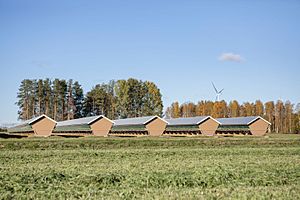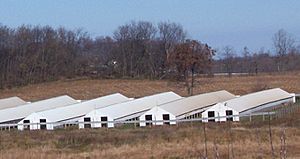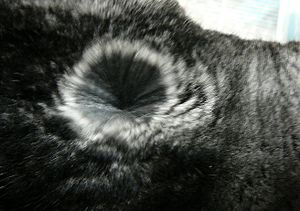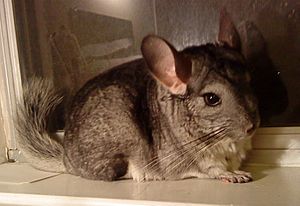Fur farming facts for kids
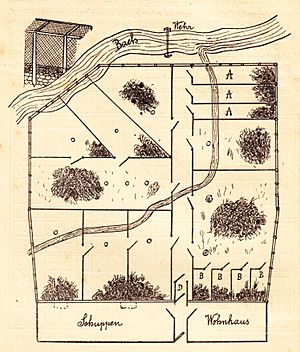
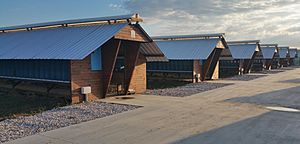
Fur farming is when people raise certain animals, like mink or foxes, just for their fur. This fur is then used to make clothing and other items.
Most of the world's farmed fur comes from Europe. In 2018, there were about 5,000 fur farms in 22 countries in the EU. These farms produced half of all farmed fur globally. The EU makes 63% of the world's mink fur and 70% of its fox fur. Denmark used to be the top mink producer. Today, the biggest fur producers are Poland and China. Finland is the main supplier of fox fur to the United States.
The United States also exports a lot of fur skins. They send fur to countries like China, Russia, Canada, and the EU. More and more fur exports from the US go to Asia. Russia was the biggest buyer of fur in 2012. China imports the most fur skins and exports the most finished fur products.
Some countries have banned fur farming. These include Austria, Croatia, the United Kingdom, the Czech Republic, the Netherlands, Norway, and Italy. In Switzerland, rules are so strict that no fur farms exist. Some other countries ban farming only certain types of animals for fur.
Demand for fur dropped in the late 1980s and 1990s. This was partly because animal rights groups spoke out. But since the year 2000, fur sales have grown a lot. New ways to work with fur and more money in China and Russia helped this growth. This led to many new fur farms in China and Poland.
During the COVID-19 pandemic, mink easily caught the virus from humans. This caused worries about the virus spreading and changing on mink farms. These changes could then infect humans with new types of the virus. This might make COVID-19 vaccines less effective. Because of this, many mink farms in the Netherlands had to kill all their animals. Spain also culled 100,000 mink in 2020. In November 2020, Denmark decided to cull its entire 17 million mink population. This was to stop a mutated strain of COVID-19 from spreading.
Contents
History of Fur Farming
People have worn fur clothing for warmth since the Stone Age. Back then, they got fur from wild animals. As more people lived on Earth, fur, leather, and hides also came from farm animals. These included sheep, rabbits, cattle, pigs, and goats.
Archaeologists found signs of red fox breeding in Scotland during the late Iron Age. This was around 800 AD. The earliest records of breeding mink for fur in North America are from the 1860s. Foxes were first raised on farms for fur in Canada in 1895.
The fur trade was very important for the economy in the United States. Fur trappers explored large parts of North America. The popular fashion for beaver hats led to strong competition for beaver fur.
Since the late 1900s, animal rights groups have criticized fur farming. They say it can be cruel to animals. They also point out that there are many other materials for clothing. These include natural fibers like cotton and man-made fibers. Today, 80% of the fur used for clothing comes from animals raised on farms. The other 20% comes from wild animals.
Animals Farmed for Fur
The most common animal farmed for fur is the mink. About 50 million mink are raised each year. Foxes are next, with about 4 million raised annually. Other animals farmed for their fur include Asiatic and Finnish raccoon, and chinchilla. Most fur farms (64%) are in Northern Europe. About 11% are in North America, and the rest are in other countries like Argentina and Russia.
Mink
Mink have been farmed for fur in the United States for 130 years. However, people in the US started buying less fur in the late 1980s. In 2010, the US was the fifth largest producer of mink fur. Denmark, China, the Netherlands, and Poland produced more.
Mink usually breed in March. They give birth to their babies, called kits, in May. Farmers vaccinate the young kits to keep them healthy. Mink are usually harvested for their fur in November and December. The ways to humanely put animals to sleep on fur farms follow guidelines from veterinary groups.
Canada also produces a lot of mink fur. Most of it comes from Nova Scotia. Black mink fur has become very popular since 2000. New markets in Russia, China, and South Korea buy most of it. Black mink was first bred in Nova Scotia in the late 1950s. Most fur from Nova Scotia is sold in China. There, it is made into fancy clothing.
Chinchilla
The trade of chinchilla fur started in the 1500s. The animal is named after the Chincha people of the Andes mountains. They wore its very soft, thick fur. By the late 1800s, chinchillas were very rare. In 1923, Mathias F. Chapman brought eleven wild chinchillas to the US to breed them. Only three of these were female.
Fox

Finland is the world's top producer of fox fur. In the United States, about 10,000 fox furs are produced each year. Canada produces ten to fifteen times more fox furs than the USA.
Dog and Cat
The United States banned importing, exporting, and selling products made from dog and cat fur in 2000. Other countries like Italy, France, Denmark, Greece, Belgium, and Australia also ban importing this fur. However, selling it is sometimes still allowed. The European Union banned these imports in 2009.
Rabbit
The main type of rabbit used in fur farming is the Rex. Breeding rabbits are kept for up to three years. They usually give birth twice a year. The baby rabbits, called kits, are taken from their mothers at four weeks old. They are then put in a nursery with other kits. After this, mothers and kits are kept separate. They are only put together for feeding.
When kits are seven to eight weeks old, they are put in their own cages. They stay there for about six to seven months. They are harvested after they have shed their winter fur. The rabbits are kept in bare wire mesh cages. A cage for one rabbit is about the size of two shoe boxes. About 10-15% of caged Rex rabbits die, mostly from breathing problems.
Mink Life Cycle on Farms
Breeding and Care (December - March)
During this time, farmers focus on getting their chosen mink ready for breeding. Mink breed once a year. It's important to feed them well and give them space to exercise. This helps them stay healthy for breeding. Farmers keep records for each mink. These records include breeding dates, family history, health, and fur quality.
Birth and Weaning (April - June)
Before giving birth, female mink are given lots of soft bedding. This helps them build a comfortable nest. Female mink need a quiet environment during this time. Pregnancy lasts from 40 to 70 days. Farmers can shorten this time by using artificial light.
Female mink usually give birth to 5-6 kits. The kits are born helpless, so the mother stays in the nest box caring for them. They drink their mother's milk for the first four weeks. Farmers check the kits often to make sure they are warm and getting enough milk. Mothers can lose a lot of weight while feeding their babies.
Weaning is when the kits stop drinking milk. This happens when they are about 6–8 weeks old. It can be a stressful time for both the mother and the kits. Farmers make sure the kits can eat solid food and drink water on their own before weaning them.
Growth and Fur Development (July - October)
Young mink grow very quickly during this time. For about 10–11 weeks, it's important that they get enough food. This food is specially made for their growing needs. Feeding them several times a day helps keep their food fresh. In July, all mink get vaccinated to prevent diseases.
By August, the mink kits have finished growing their bones. After that, they mostly gain fat. Their fur starts to grow in the fall. It begins at the tail and grows up to the head. Farmers keep the barns clean and healthy during this time. They clean nest boxes and remove waste. They work hard to make sure the animals are comfortable.
Grading and Harvesting (November - December)
In November or early December, mink are checked carefully. Farmers look at their fur color, features, and quality. Fur quality and skin size are very important. Each mink gets a grade based on its fur. This helps farmers decide which mink to keep for breeding next year. Farmers or special graders judge the fur quality, color, and body size.
The methods used to harvest mink include neck breaking, electricity, carbon monoxide, carbon dioxide, nitrogen, argon, and lethal injection. The most common method is using a chamber with carbon monoxide. The fur is then removed from the animal, either at the farm or at another location.
By-products of Fur Farming
After the fur is removed, the mink bodies are usually sent to be burned or processed. They can be turned into bone and meat meal. The meat from most fur animals is not eaten by humans. So, the bodies become other products. These include pet food, animal feed, organic compost, fertilizer, paint, and even tires.
Sometimes, the bodies go to animal sanctuaries, zoos, and aquariums to feed other animals. Some are used as crab bait. Some companies offer preserved mink bodies for school dissection classes. Mink waste is used as fertilizer for crops. Mink fat is made into oil for soap, face oils, cosmetics, and leather treatments.
COVID-19 and Fur Farms
Denmark
On November 6, 2020, Denmark announced it would cull its entire 17 million mink population. This was an emergency step to stop a mutated type of COVID-19 from spreading. At least five cases of this new type were found. By November 9, over 200 people had caught a mink-related coronavirus. Seven areas in northern Denmark were put under strict lockdown.
The culling was paused on November 10 due to political disagreement. Some argued there wasn't enough scientific proof that the new virus was dangerous. By then, 2.5 million mink had already been culled. A group for Danish fur farmers agreed that the culling should happen. But they wanted a fair agreement on how farmers would be paid for their losses. Meanwhile, the mutated virus had spread to hundreds of other mink farms in Denmark.
Even though the Danish government stopped the mandatory culling, they still suggested it. So, culling continued voluntarily. Kopenhagen Fur, a large fur company, said it would slowly stop its business. This was because the situation had badly hurt the future of the global fur trade. A report from the ECDC warned that the Danish mink-mutated coronavirus, called Cluster 5, was a danger. However, how serious it was wasn't fully known yet.
Netherlands
During the COVID-19 pandemic in the Netherlands, by May 25, 2020, there were two cases where mink had infected humans with a changed form of the virus. There was strong pressure on the Agriculture Minister to immediately cull all mink. This was to stop the new virus from spreading to humans.
In early June, the Minister decided that 10 mink farms had to cull their animals. This was to prevent the coronavirus from spreading. On June 6, 2020, the culling of about 1,500 mother mink and their pups began at a farm. Nine other farms followed. On August 27, 2020, the government decided to ban fur farming earlier, by March 1, 2021. This decision was made because more and more mink farms were getting infected. The fur farming business had also lost its economic value and political support.
On November 11, the Dutch government decided to move the ban forward again. The new target date was January 1, 2021. This was to limit the risk of the virus changing. By then, more than half of all mink farms had been infected and culled. Preventive culling of farms not yet infected was also happening.
United States
The Centers for Disease Control and Prevention (CDC) said on November 4, 2020, that 11 mink farms in the United States were infected with COVID-19. These included farms in Utah, Wisconsin, and Michigan. At least 8,000 mink had died from the coronavirus at farms in Utah. Almost 3,400 died at a Wisconsin farm. The Humane Society Veterinary Medical Association suggested culling the mink. This was to prevent infections and especially mutations of the virus.
|
See also
 In Spanish: Granja de peletería para niños
In Spanish: Granja de peletería para niños


